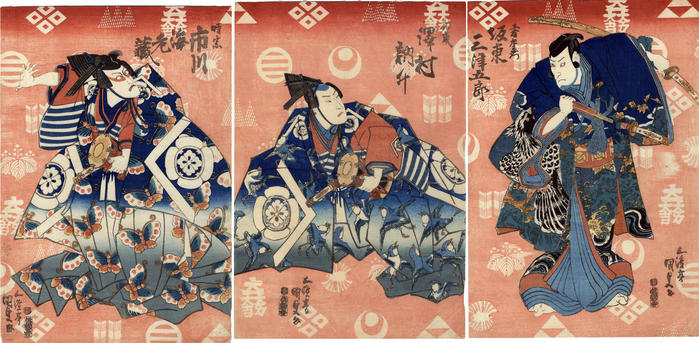Utagawa Kunisada (歌川国貞) / Toyokuni III (三代豊国) (artist 1786 – 01/12/1865)
Actors with multiple mon as a backdrop: Bandō Mitsugorō IV (坂東三津五郎) as Kudō Suketsune on the right; in the center is Sawamura Tosshō I (澤村訥升) as Soga Jūrō and Ichikawa Ebizō V (市川海老蔵) playing Soga Gorō on the left
01/1833
30 in x 14.25 in (Overall dimensions) Japanese color woodblock print
Signed: Gototei Kunisada ga
五渡亭国貞画
Publisher: Sanoya Kihei (Marks 446 - seal 25-210)
Censor's seal: kiwame
Hankyu Culture Foundation - right panel
Hankyu Culture Foundation - center panel
Hankyu Culture Foundation - left panel
Museum of Fine Arts, Boston - 1833 playbill for this and one other play Matthi Forrer wrote about a surimono pentaptych by Yashima Gakutei in the Rijksmuseum. In that description he gave a succinct summary of the significance of the Soga themed plays which started off each New Year's celebration.
"The theme of the play is the revenge of the Soga brothers, Soga no Jūrō Sekenari, the elder, and the younger and more impetuous Soga no Gorō Tokimune, whose father had been murdered by Kudō Suketsune in 1176 while they were both very young. Eighteen years later, the brothers set out to avenge their father, and inform Kudō Suketsune of their intention to kill him. He taunts them incessantly, even suggesting they visit him at his palace, an invitation they can't refuse. Later, in 1193, they join him in a hunt at the foot of Mt. Fuji and kill him that night in his tent. Asahina Saburō, assigned the role of jester in the play, was the retainer of Kudō Suketsune who joined forces with the Soga brothers before they exacted revenge. The adventures of the brothers formed the basis of traditional New Year's plays staged at the Edo kabuki theatres, which constantly invented new episodes to captivate their audiences."
****
On each of these figures there is an iori mokko (庵木瓜) or crest of a four-petaled 'magnolia' flower sheltered under the roof of a hut. This motif is most commonly associated with the Soga brothers. The brothers have this crest prominently displayed on their robes, while on Suketsune's clothing it is more subtly shown only on his obi. In a 1981 Andon: Bulletin of the Society for Japanese Arts and Crafts it notes that Kudō and the brothers were first cousins once removed, and the boys often wear the same crest without the sidewalls on their formal clothes." This distinction can be seen clearly in this triptych.
Another point of interest is the fact that each costume displays some sort of flying creature: butterflies on the left, sparrows (?) in the middle and a hawk or eagle on the right. (JSV)
****
This illustrates a performance from the play Fuji o Ōgi to Mimasu Soga (富士扇三升曽我- ふじをおうぎみますそが). (JSV)
Sanoya Kihei (佐野屋喜兵衛) (publisher)
actor prints (yakusha-e - 役者絵) (genre)
Sawamura Tosshō I (初代沢村訥升 or 澤村訥升: from 11/1831 to 6/1844) (actor)
Bandō Mitsugorō IV (四代目坂東三津五郎: from 3/1832 to 10/1850) (actor)
Ichikawa Ebizō V (五代目市川海老蔵: 11/1797 to 10/1800 and 3/1832 to 3/1859) (actor)
Soga brothers (曾我兄弟) (genre)
